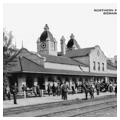It would be hard to point to a more pervasive impact on buildings and landscapes than the two transcontinental railroads Northern Pacific and Great Northern and the multiple spur lines that speculatively platted countless towns and cities, often naming them to appeal to particular immigrant groups. Land grants were offered to railroad entrepreneurs and speculators, resulting in a checkerboard of parcels they offered for sale and supplementing the federal homesteading initiative. Bonanza farms in the Red River Valley afforded the proof that these lands could be productive. Railroad recruitment agents in European newspapers and East Coast cities aggressively marketed North Dakota settlement land. The railroad companies dropped off groups of immigrants at railhead town sites about every fifteen miles.
Railroad companies profited from the sale of farmland and town lots, from passenger transportation and freight shipment for buildings and agricultural items, and from every additional possible means. In turn, the railroad companies tied up the resources of investors in track, cut and fill, bridges, trestles, depot stations, rolling stock, and the infrastructure needed for railroad operations. The result was a ready-made boom and a self-fulfilling prophecy tied largely to the production and marketing of a particular variety of hard red Durham wheat demanded by millers in Minneapolis and St. Paul.
Working from standardized town plans, railroads literally brought architecture to North Dakota. These new towns created the need and market for architectural services, and architects traveled the extensive network of passenger rail lines to meet with clients and to inspect building projects under construction. Architects in the state’s larger cities maintained convenient access to a client base in even the tiniest of towns. North Dakota looks the way it does today in terms of land use patterns and distribution of architectural styles because of the vision of countless national and local railroad companies operating in competition. Companies that supplied architectural materials marketed a full range of standard manufactured products and materials suited to emerging styles and tastes promoted in popular magazines and architectural journals. A cadre of salesmen called on retailers from local lodgings in United Commercial Travelers UCT hotels.
Writing Credits
If SAH Archipedia has been useful to you, please consider supporting it.
SAH Archipedia tells the story of the United States through its buildings, landscapes, and cities. This freely available resource empowers the public with authoritative knowledge that deepens their understanding and appreciation of the built environment. But the Society of Architectural Historians, which created SAH Archipedia with University of Virginia Press, needs your support to maintain the high-caliber research, writing, photography, cartography, editing, design, and programming that make SAH Archipedia a trusted online resource available to all who value the history of place, heritage tourism, and learning.



